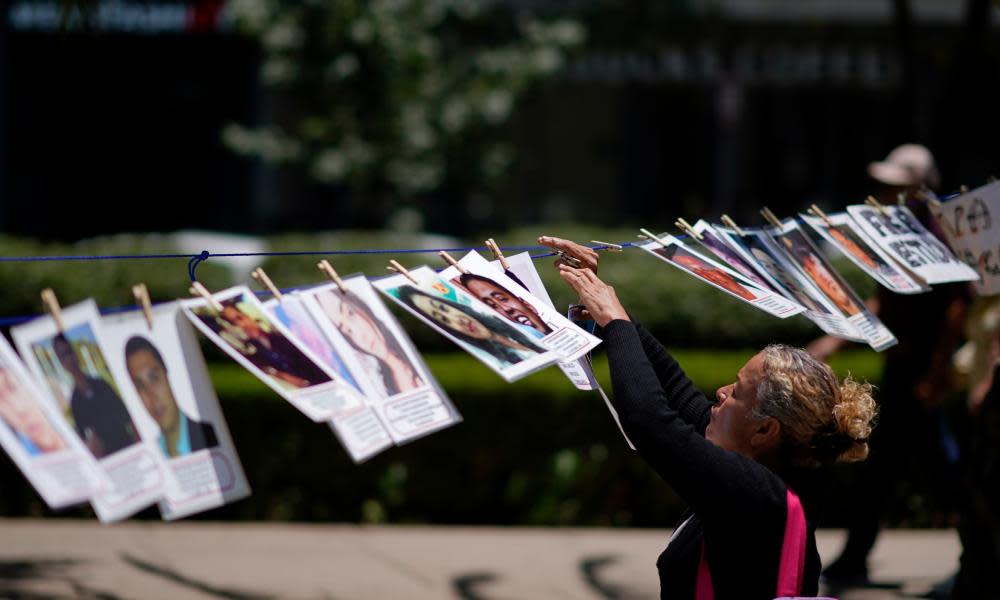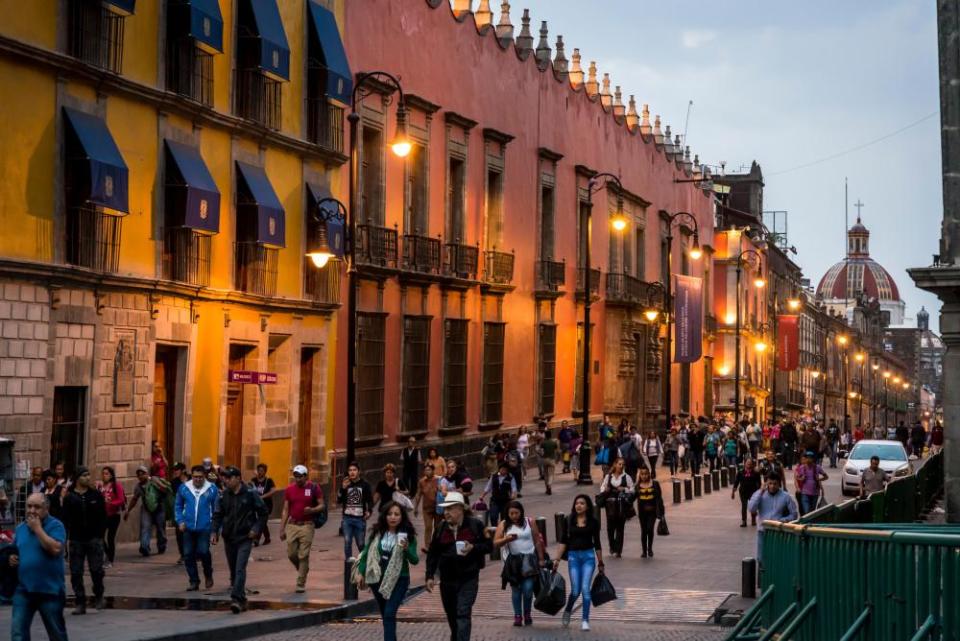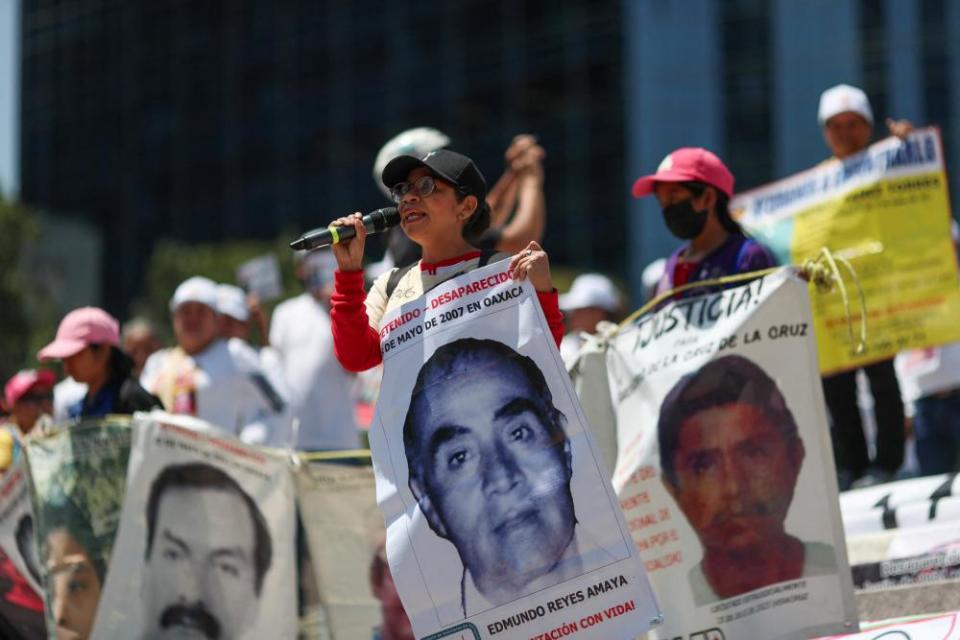Is Mexico City’s plummeting murder rate too good to be true?

- Oops!Something went wrong.Please try again later.
- Oops!Something went wrong.Please try again later.
- Oops!Something went wrong.Please try again later.
“I’d like to ask you to close your eyes.”
“Imagine a woman, 32 years old, 165cm tall. Slim, with light brown skin and slender arms with soft black hair. An oval face and a button nose that turned up at the end. Intense, coffee-coloured eyes. Eyes that expressed joy, anger, calm and sadness.”
Juana Laura Garrido’s voice wavered, but never broke, as she described Viviana, her sister, who vanished almost five years ago in Mexico City.
Garrido was taking part in a seminar that sought to shed light on the thousands of people that have disappeared in the Mexican capital – and challenged the city government’s narrative that security has improved dramatically on its watch.
Such questions could shape next year’s election, as Claudia Sheinbaum, who led the Mexico City government from 2018 until recently, runs for president.
Violence in Mexico soared with the launch of the militarised “war on drugs” in 2006, and it has remained stubbornly high throughout the term of the president, Andrés Manuel López Obrador, which began in 2018.
Calderón sends in the army
Mexico’s “war on drugs” began in late 2006 when the president at the time, Felipe Calderón, ordered thousands of troops on to the streets in response to an explosion of horrific violence in his native state of Michoacán.
Calderón hoped to smash the drug cartels with his heavily militarized onslaught but the approach was counterproductive and exacted a catastrophic human toll. As Mexico’s military went on the offensive, the body count skyrocketed to new heights and tens of thousands were forced from their homes, disappeared or killed.
Kingpin strategy
Simultaneously, Calderón also began pursuing the so-called “kingpin strategy” by which authorities sought to decapitate the cartels by targeting their leaders.
That policy resulted in some high-profile successes – notably Arturo Beltrán Leyva, who was gunned down by Mexican marines in 2009 – but also did little to bring peace. In fact, many believe such tactics served only to pulverize the world of organized crime, creating even more violence as new, less predictable factions squabbled for their piece of the pie.
Under Calderón’s successor, Enrique Peña Nieto, the government’s rhetoric on crime softened as Mexico sought to shed its reputation as the headquarters of some the world’s most murderous mafia groups.
But Calderón’s policies largely survived, with authorities targeting prominent cartel leaders such as Sinaloa’s Joaquín “El Chapo” Guzmán.
When “El Chapo” was arrested in early 2016, Mexico’s president bragged: “Mission accomplished”. But the violence went on. By the time Peña Nieto left office in 2018, Mexico had suffered another record year of murders, with nearly 36,000 people slain.
'Hugs not bullets'
The leftwing populist Andrés Manuel López Obrador took power in December, promising a dramatic change in tactics. López Obrador, or Amlo, as most call him, vowed to attack the social roots of crime, offering vocational training to more than 2.3 million disadvantaged young people at risk of being ensnared by the cartels.
“It will be virtually impossible to achieve peace without justice and [social] welfare,” Amlo said, promising to slash the murder rate from an average of 89 killings per day with his “hugs not bullets” doctrine.
Amlo also pledged to chair daily 6am security meetings and create a 60,000 strong national guard. But those measures have yet to pay off, with the new security force used mostly to hunt Central American migrants.
Mexico now suffers an average of about 96 murders a day.
But throughout this, Mexico City seemed to be an anomaly.
Official data show the rates of “high-impact” crimes, such as murder, kidnap and robbery, falling across the board since 2019, and the public’s perception of insecurity improving.
Most strikingly of all, homicides in the capital appear to have fallen by half.
Mexico’s national murder rate in 2022 was 25.2 per 100,000 people – with more than 30,000 murders for the fifth year in a row – but in Mexico City the rate has fallen to 8 per 100,000, similar to US cities like Los Angeles and Phoenix.
This has coincided with a boom in remote working from Mexico City, as digital nomads flock from the US and Europe to live somewhere much cheaper – and apparently just as safe as their home countries.

Sheinbaum is the clear favourite to become Mexico’s next president as the endorsed successor of López Obrador, and she has made security improvements in Mexico City an important part of her platform.
She has also suggested that the policies implemented in the capital could be expanded nationwide if she becomes president.
But one data point complicates the picture: the ever-growing number of disappeared people in the capital. Each year hundreds, sometimes more than a thousand, go missing.
Related: ‘The disappeared’: searching for 40,000 missing victims of Mexico’s drug wars
This has spurred investigators to take a closer look at the city’s success story.
“I think it’s quite probable that lots of the people who disappeared have in reality been murdered,” said Elena Azaola, an academic and member of the citizen council for the Search Commission in Mexico City. “And these homicides are not being counted.”
Azaola’s research underlines that the official data on homicides and disappearances is so fragmented and inconsistent that it is hard to draw any conclusions with confidence.
Mexico’s forensic service, its National Geography and Statistics Institute and the National Public Security System each compile their own homicide tallies – and most years those totals differ by hundreds.
Meanwhile, every year since 2016, the cause of between 25 and 47% of violent deaths has not been identified, making it difficult to know if they were homicides, suicides or accidents. This proportion is far higher in Mexico City than anywhere else in the country, for reasons that are unclear.
“These discrepancies and inconsistencies are getting more and more serious,” said Azaola. “The only conclusion I have is that we don’t know [the true number of homicides].”
This uncertainty applies equally to the number of disappearances, where various institutions have their own registers. The periods of the data do not align perfectly, but over roughly the same period from 2019 to 2023, their totals range from about 1,000 to 10,000 disappeared people.
According to the National Search Commission, which has data going back decades, there appears to have been a surge in the number of disappearances in Mexico City since 2019. In the four preceding years, 285 people disappeared. But in the four years since, 3,598 people did.

The city government argues that the figures instead show that more cases are being reported since national and city-level search commissions were established in 2017 and 2019 respectively.
It is also possible that the number of disappearances is inflated. For example, some of the people reported as disappeared do turn up shortly after, but their names are never removed from the register.
Currently the prosecutor’s office of Mexico City – whose data feeds the National Search Commission – is revising the register to remove such cases.
“The problem is that there is political pressure to reduce the number of disappeared people, so we don’t know if they will do a serious or responsible job,” said Azaola.
The same story is playing out at the national level, where López Obrador announced a census to review the official total of disappearances, which has exceeded 110,000.
Karla Quintana, who led the National Search Commission, resigned shortly after that announcement. “Their intention is very clear and it is regrettable: it is to reduce the number of disappeared people, mainly during this government,” said Quintana.
“For now, again, the only certainty is: we don’t know [the true numbers],” said Azaola.
The debate over these data looks set to intensify in the run up to the election, with some defending the city government’s record, while others suggest it could be massaging the data.
“With all honesty, I am in the middle of this debate, and I don’t know,” said Rodrigo Peña, executive director of Seminars on Violence and Peace. “But I’ve started to question the way in which not just academics but officials have used crime statistics. I think we’ve fetishised the homicide rate, and some authorities have grasped this and become fixated on reducing homicides, as if this were the lever to reduce all violent crime.”
“And there are people for whom it is important that this issue isn’t in the spotlight,” he added. “Because the good impression of the security of Mexico City matters for the election.”

